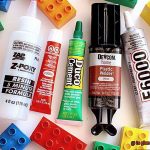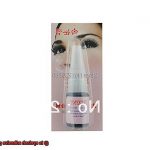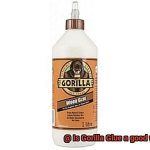If you’ve ever found yourself pondering the question of whether Gorilla Glue can hold its own as a silicone adhesive, you’re in for a wild ride. Prepare to have your mind blown as we uncover the truth about this versatile adhesive solution.
Gorilla Glue has made quite a name for itself in the world of adhesives. Its strength and sticky prowess have left many wondering if it’s secretly a silicone glue in disguise. Well, my friends, today we’re going to dive deep into the realm of Gorilla Glue and explore its features, benefits, and potential applications alongside traditional silicone glues.
So, whether you’re a DIY enthusiast looking to conquer your next project or a pro craftsman seeking the perfect adhesive sidekick, grab your seat and get ready for an adventure. We’re about to unravel the mysteries behind Gorilla Glue’s incredible bonding capabilities and discover just how it measures up as a silicone glue alternative.
Get ready to unleash your inner adhesive expert as we embark on this journey through the fascinating world of Gorilla Glue. From arts and crafts to home repairs, we’ll explore all the scenarios where this mighty adhesive can be your go-to solution.
So buckle up and join us on this quest for knowledge – together, we’ll determine once and for all if Gorilla Glue truly deserves its spot among the silicone glue greats. Let’s get sticky with it.
What is Gorilla Glue?
Contents
- 1 What is Gorilla Glue?
- 2 What is Silicone Glue?
- 3 Differences Between Gorilla Glue and Silicone Glue
- 4 Chemical Composition of Gorilla Glue and Silicone Glue
- 5 Curing Process of Gorilla Glue and Silicone Glue
- 6 Expansion Properties of Gorilla Glue and Silicone Glue
- 7 Water Resistance of Gorilla Glue and Silicone Glue
- 8 Choosing the Right Adhesive for Your Project
- 9 Conclusion
When it comes to adhesive strength and versatility, few products can match the remarkable capabilities of Gorilla Glue. Introduced in 1994, this polyurethane-based adhesive has gained a loyal following among DIY enthusiasts and professionals alike. Let’s explore the world of Gorilla Glue and discover why it has become the go-to choice for countless repairs and construction projects.
Unleashing the Power of Polyurethane:
Gorilla Glue is not your average silicone adhesive. Its polyurethane composition gives it a unique edge in terms of bonding strength and versatility. From wood to metal, ceramics to glass, foam to stone, Gorilla Glue creates reliable, long-lasting bonds on various materials.
![]()
Strength Beyond Measure:
Gorilla Glue forms an incredibly strong bond that can handle heavy loads and extreme conditions. It ensures that your projects stand the test of time, whether you’re repairing broken furniture or constructing intricate wooden structures.
Expanding Horizons:
One standout feature of Gorilla Glue is its ability to expand as it cures. This expansion allows it to fill gaps and irregularities, maximizing contact between the adhesive and the surface for an even stronger bond. No matter how challenging the surfaces may be, Gorilla Glue rises to the occasion.
Waterproof Warrior:
Gorilla Glue is a reliable ally for projects that require a waterproof seal or may be exposed to moisture. Once cured, it becomes resistant to water, making it suitable for both indoor and outdoor applications. Leaky outdoor furniture or sturdy birdhouses? Gorilla Glue has got you covered.
A Little Goes a Long Way:
With Gorilla Glue, a small amount can go a long way. Due to its potent formula, it is recommended to use it sparingly to avoid waste or messy application. A little dab unleashes the adhesive prowess of Gorilla Glue.
Why it’s a DIYer’s Dream:
Gorilla Glue empowers DIY enthusiasts with professional-quality results. From repairing wooden shelves to fixing broken ceramics, creating custom decorations to constructing furniture, Gorilla Glue is an indispensable tool in any DIYer’s arsenal. Its strength, versatility, and durability make it the adhesive of choice.
What is Silicone Glue?
Silicone glue is a powerful adhesive that is formulated with silicone as its main component, making it one of the most versatile and effective glues on the market. Its exceptional bonding capabilities allow it to bond with a wide range of materials, including glass, metal, plastic, rubber, and ceramics. Say goodbye to frustrating glue failures and hello to reliable adhesion.
But that’s not all – silicone glue is also incredibly resistant to water, heat, chemicals, and even UV radiation. Whether you need to use it indoors or outdoors, this adhesive can withstand anything Mother Nature throws at it. It’s like having a glue that can tackle any project with ease.
When it comes to application, silicone glue offers flexibility and convenience. It can be applied using brushes or spreaders and comes in various forms such as tubes, bottles, or syringes. Its thick and sticky consistency allows it to fill gaps and create a strong bond between surfaces. It’s like having a superhero sidekick that can handle any project.
But perhaps one of the most impressive qualities of silicone glue is its ability to remain flexible even after it has cured. This means that it can accommodate slight movements or vibrations without cracking or breaking. So if you’re working on a project that requires flexibility, such as sealing joints or repairing flexible materials, silicone glue is your go-to adhesive.
Before you rush out to buy any glue labeled as “silicone,” it’s important to note that not all products are created equal. Some may contain other ingredients along with silicone to enhance certain properties or reduce costs. To ensure that you’re getting the real deal, make sure to read the product label and check the ingredients.
Differences Between Gorilla Glue and Silicone Glue
When it comes to adhesive superheroes, Gorilla Glue and Silicone Glue are two heavyweights in the industry. But what sets them apart? Let’s take a closer look at the differences between these two popular types of glue.
First off, let’s talk composition. Gorilla Glue is a polyurethane-based adhesive, while Silicone Glue is made from silicone polymers. This distinction in composition leads to variations in their performance and applications.
Gorilla Glue is known for its incredible strength and versatility. It bonds well with a wide range of materials, including wood, metal, glass, ceramics, and more. It expands as it dries, filling in gaps and creating a strong bond. However, be prepared for some messiness as it tends to foam up during application.
On the other hand, Silicone Glue is like a flexible superhero. It forms a strong yet flexible bond that can withstand extreme temperatures and is perfect for outdoor applications. If you need to seal windows or doors and require a waterproof seal, Silicone Glue is your go-to hero.
The curing process is another area where these glues differ. Gorilla Glue cures through a chemical reaction with moisture present in the air or on the surface being bonded. This means you’ll need to apply pressure or use clamps during the curing process to ensure a strong bond. Once fully cured, it becomes hard and durable.
Silicone Glue, on the other hand, cures by evaporation of solvents or by a chemical reaction with moisture. It doesn’t require any clamping or pressure during the curing process. Instead, it forms a flexible rubber-like bond that can move with the materials being bonded without losing its adhesive properties.
Now let’s talk drying time. Gorilla Glue takes its time to dry completely, often taking several hours or even overnight to reach maximum strength. On the flip side, Silicone Glue usually dries within 24 hours, making it a quicker option for projects that require a fast turnaround.
![]()
But what about removal? Gorilla Glue can be a tough contender to remove once it’s fully cured. You’ll need to break out the sandpaper or scraper to remove the hardened adhesive. Silicone Glue, on the other hand, can be easily cut or peeled off from the surface without leaving much of a trace.
Lastly, let’s talk price. Gorilla Glue tends to be more expensive than Silicone Glue. This is due in part to its versatile bonding capabilities and superior strength.
Chemical Composition of Gorilla Glue and Silicone Glue
Gorilla Glue and Silicone Glue are two popular adhesive options, each with their own unique chemical compositions and characteristics.
Gorilla Glue is a polyurethane-based adhesive that combines isocyanate and polyol. Isocyanate, a highly reactive compound, reacts with polyol to form a strong bond. This chemical composition gives Gorilla Glue its exceptional strength and versatility. It can be used on various surfaces, including wood, metal, ceramic, and plastic. One of its standout features is its ability to expand as it cures, filling gaps and creating a tight seal. This expansion property makes it ideal for projects that require a secure bond or filling voids.
Silicone Glue, on the other hand, is composed of silicone polymers. Silicone is a synthetic material made up of repeating units of siloxane, which consists of alternating silicon and oxygen atoms. This unique chemical composition gives silicone glue its flexibility, heat resistance, and water resistance. Silicone glue forms a strong yet flexible bond that remains intact even under extreme temperatures or when subjected to movement or stress. It is commonly used for sealing and repairing applications where flexibility and durability are required.
In terms of specific uses, Gorilla Glue is commonly used in woodworking projects to join pieces of wood together or repair furniture. It can also be used for bonding metal or plastic components. On the other hand, silicone glue is often used for sealing purposes, such as sealing gaps or cracks in windows, doors, or plumbing fixtures. It is also utilized in electronics to create waterproof seals around connectors or bond components together.
![]()
Curing Process of Gorilla Glue and Silicone Glue
Gorilla Glue and silicone glue are adhesive superheroes, each with their own unique curing process that sets them apart. Let’s explore the captivating world of their curing processes and see how they work their magic.
First up is Gorilla Glue, a polyurethane-based adhesive that relies on a chemical reaction with moisture to cure. When this glue comes into contact with water or moisture in the air, it awakens from its slumber and begins to expand. Picture it as a powerful force, seeping into every nook and cranny, creating a bond as strong as steel. The curing process of Gorilla Glue can take anywhere from 1 to 24 hours, depending on factors like humidity and temperature. So be patient, my friend, and let this adhesive superhero work its sorcery.
Now, let’s turn our attention to silicone glue, an adhesive hero with a different method of curing. As silicone glue dries, it releases acetic acid into the atmosphere, giving off that distinct vinegar-like smell. The transformation is underway as the acetic acid escapes, turning the liquid state into a solid rubbery material. The curing time for silicone glue can vary from a few minutes to several hours, depending on factors like temperature and humidity. So give it the time it needs to fully cure before unleashing its power.
To unlock the full potential of both Gorilla Glue and silicone glue, proper surface preparation is essential. Cleanliness is key, my friend. Ensure that the surfaces are pristine, dry, and free from any dirt or debris. A gentle scrub with alcohol or mild detergent will do the trick. And if the surfaces are too smooth, roughen them up with sandpaper to provide more grip for these adhesives.
During the curing process, don’t forget about ventilation. No one wants to be overwhelmed by fumes or odors. And remember to apply even pressure on the bonded surfaces as they cure. Clamps or weights will hold everything in place, ensuring a strong, uniform bond.
Expansion Properties of Gorilla Glue and Silicone Glue
Look no further, because today we are going to explore the expansion properties of two remarkable glues: Gorilla Glue and Silicone Glue.
Let’s start with Gorilla Glue. This adhesive is renowned for its incredible strength and versatility. Once applied, it forms a bond that is as unyielding as steel. But here’s the fascinating part – Gorilla Glue does not undergo significant expansion as it dries. Instead, it relies on its unique chemical composition to create an unbreakable bond. So, if you’re seeking a glue that won’t cause any unwanted expansion, Gorilla Glue is your go-to option.
On the other hand, we have silicone glue, which possesses an intriguing property – it expands when it cures. This expansion allows silicone glue to fill in gaps and create a robust bond even on irregular surfaces. In fact, this expansion property makes silicone glue perfect for sealing and waterproofing applications. So, if you’re working on a project that requires filling in gaps or ensuring a watertight seal, silicone glue is the way to go.
Now, you might be wondering, which one should I choose? Well, it all depends on your specific application. If you need a glue that provides incredible strength without any significant expansion, Gorilla Glue is the perfect choice. On the other hand, if you’re looking for a glue that can fill in gaps and create a reliable waterproof seal, silicone glue is your best bet.
Water Resistance of Gorilla Glue and Silicone Glue
When it comes to water resistance, Gorilla Glue and silicone glue are two top contenders in the adhesive world, but they each have their own unique characteristics.
Gorilla Glue, renowned for its versatility and strong adhesive properties, becomes water-resistant once fully cured. This means that it can withstand occasional contact with water without losing its bond. However, it’s important to note that Gorilla Glue is not completely waterproof and may degrade over time if constantly exposed to water. So, while it can handle a splash or two, it’s not the best choice for applications where constant water exposure is expected.
On the other hand, silicone glue is inherently waterproof due to its silicone polymer composition. It forms a flexible and durable seal that can withstand exposure to water, making it the ideal choice for sealing bathroom fixtures or repairing aquariums. Silicone glue maintains its integrity and adhesive properties even when submerged in water for extended periods, outperforming Gorilla Glue in terms of performance under water.
So, which one should you choose? It depends on the specific requirements of your project. If you need a completely waterproof seal, silicone glue is the way to go. It will provide a reliable bond that can withstand even the harshest aquatic environments. However, if water resistance is sufficient and you desire other adhesive properties like versatility and strength, Gorilla Glue can be a suitable choice.
Remember to always follow the manufacturer’s instructions for proper application and any specific recommendations for water exposure. This will ensure the best results and longevity of the bond in water-based applications.
Choosing the Right Adhesive for Your Project
Choosing the perfect adhesive is a critical step in ensuring the success of your project. With an overwhelming array of options available, it can be challenging to determine which adhesive will best suit your needs. However, fear not. We are here to provide you with a comprehensive guide to help you make an informed decision.
Let’s start by exploring the different types of adhesives available in the market. From glue sticks for lightweight crafts to liquid glue for paper and cardboard, tape for quick fixes, epoxy for heavy-duty bonding, and silicone glue for waterproof projects, there is an adhesive for every requirement.
Speaking of silicone glue, let’s delve deeper into its unique properties. This extraordinary adhesive is inherently waterproof, flexible, and durable. It is an excellent choice for sealing bathroom fixtures or repairing aquariums – anything that demands a reliable bond in a watery environment. However, it’s important to note that while Gorilla Glue can withstand occasional water contact once cured, it is not entirely waterproof like silicone glue.
Now, you may be wondering if Gorilla Glue is a silicone glue. The answer is no. Although both adhesives possess excellent water resistance, they have their own distinctive qualities. Gorilla Glue offers versatility and strength for various applications, making it a popular choice among DIY enthusiasts and professionals alike.
If your project specifically requires silicone glue, fret not. There are numerous alternatives available on the market that offer similar waterproof properties. Ensure you carefully read the label and select one that meets your specific needs.
When selecting an adhesive, consider factors such as material compatibility, flexibility, durability, and water resistance. Reading product labels and following manufacturer instructions will guarantee optimal results and longevity in water-based applications.
COHIVsoAU60″ >
Also Read: Will Gorilla Glue damage rubber?
Conclusion
To wrap things up, it’s clear that Gorilla Glue and silicone glue are not one and the same. These adhesives may share a knack for repelling water, but their compositions and characteristics set them apart.
Gorilla Glue steals the show with its polyurethane-based formula, renowned for its Herculean strength and adaptability. This adhesive forms an unbreakable bond on a variety of materials, expanding as it cures to fill gaps and create an impenetrable seal. Woodworking projects, furniture repairs, or even metal and plastic bonding – Gorilla Glue can handle it all.
On the flip side, silicone glue takes center stage with its silicone polymer makeup and built-in waterproof properties. This adhesive boasts a flexible yet rock-solid bond that laughs in the face of water exposure. From sealing bathroom fixtures to patching up aquariums, silicone glue remains steadfast even when submerged for what feels like an eternity.
When choosing your adhesive accomplice, keep in mind factors like material compatibility, flexibility, durability, and specific needs such as water resistance. While Gorilla Glue can brave occasional encounters with moisture once fully cured, it doesn’t quite reach the waterproof heights of silicone glue.
To ensure top-notch results and long-lasting performance in water-based applications, always read product labels diligently and follow manufacturer instructions to a tee. Whether you crave the might of Gorilla Glue or the watertight capabilities of silicone glue, rest assured that there’s an adhesive out there tailored perfectly to your unique demands.





